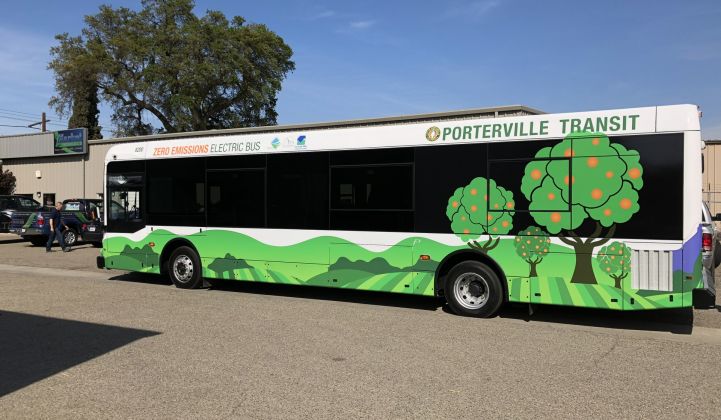Utility Southern California Edison has broken ground on a major charging investment for medium- and heavy-duty vehicles, despite the ongoing coronavirus epidemic.
The $356 million Charge Ready Transport program will see SCE laying the groundwork for at least 870 commercial charging stations over the next five years, expected to be capable of powering at least 8,490 vehicles. It constitutes a considerable early utility foray into charging infrastructure at a time when utilities across the country are figuring out what role they should play in the emerging overlap between the electric grid and the transportation sector.
SCE’s utility territory covers the greater Los Angeles region, which contains a bustling shipping logistics industry as well as persistent air pollution issues. But it also stretches inland to the Nevada border, and north into California’s Central Valley. The initial sites include three school bus charging depots for the towns of Lancaster, Visalia and Porterville, as well as two Porterville Transit sites.
Together, those sites will fuel 80 electric school and transit buses, said Justin Bardin, SCE program manager for Charge Ready Transport.
SCE brings the grid upgrades; customers bring the charger
The construction work, made possible during social distancing thanks to remote and virtual inspections, comes as electric buses are popping up in national climate policy conversations.
The Biden-Sanders Unity Task Force, convened to build policy consensus among the leading factions in the Democratic presidential primary, released its climate and energy proposals last week. That list included a call to convert the national school bus fleet to zero-emission vehicles in the next five years. Doing so would involve swapping around 500,000 buses, and would require accompanying investment in the equipment to charge those buses.
SCE’s approach offers one model for how to accomplish this. The plan, approved by the California Public Utilities Commission in 2018, empowers the utility to pay for and install the “make ready” equipment: any distribution grid upgrades needed to deliver the power, plus a meter and in some cases customer-sited panel and wiring. It falls to the customers to acquire the actual chargers of their choice, but certain customers can apply for rebates to lower the cost.
Stacking a few high-powered bus chargers in one site can easily require substantial distribution grid upgrades to actually deliver the requisite charge; such fees can deter customers from making the switch if they have to bear the cost.
The Charge Read Transport program takes that barrier off the table for customers while giving the utility scope to invest money in grid upgrades, giving both parties something to get excited about.
"It really is about helping businesses get past that initial hurdle that can sometimes seem so insurmountable," Bardin said in an interview. "We're confident that once they start [electrifying fleets], they're going to fall in love with it."
Plenty of funding still available
Regulators stipulated that at least 40 percent of the funding has to go to disadvantaged communities or transit agencies, and 25 percent must go to ports and warehouses. Electrification of trucking took on new urgency last month when the California Air Resources Board ruled that the state’s truck fleet must begin the transition to zero-emission in 2024.
So far, 55 projects are moving through various stages of the application process, Bardin said. That number includes 24 sites that have officially reserved funding, five of which are now under construction and should wrap up around September. Roughly one-third of the initial applications came from school districts.
"If you were going to look at a vehicle that’s ideal for electrification, a school bus is it," Bardin said.
School buses have long dwell times in which they can charge, and short routes. Plus, they often can use Level 2 chargers instead of more expensive, high powered ones.
Those initial applications leave the vast majority of the Charge Ready Transport funding available. But the menu of heavy duty electric vehicles is still small; applicants in a few years will have many more options to choose from.
The costs of grid upgrades for vehicle charging have inspired new business models, like FreeWire Technologies, which builds batteries into fast-charging stations to reduce their instantaneous demand on the grid. Amply Power helps fleet operators manage their charging schedules to reduce power bills once they switch to electric.
On the passenger vehicle side, Michigan utility DTE recently rolled out an infrastructure-free program to reorient charging schedules around peak grid demand. Up to 1,000 drivers will earn $8 a month for charging outside of peak hours, as verified by advanced metering data and software analytics from Sagewell. That allows the utility to enroll drivers without needing to install any new hardware.
Updated with additional information from an interview with Bardin.




